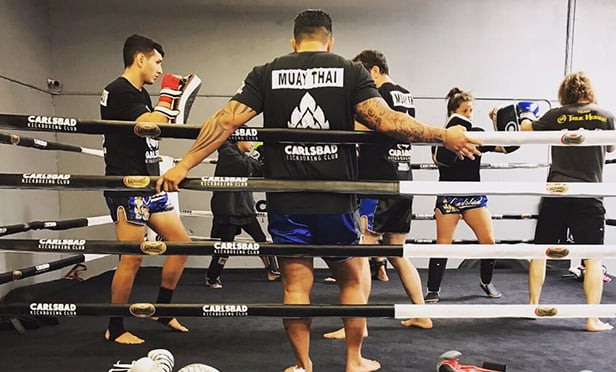SAN DIEGO—When Carlsbad Kickboxing Club, a local boutique gym in Southern California headed by US veteran Rolando Montana, had to close its doors last month it knew there was grim times ahead. Many of its members froze their monthly payments as they hunkered at home and in some cases, lost their jobs. And of course, the rent was due. Montana has received a few months forbearance from his two landlords, but he acknowledges that he won't be able to last more than a five months without paying customers.
Still, the gym is trying its best to stay afloat. It is connecting with its current members, putting together online classes for those that want to practice their moves at home. The company has even loaned out its gym equipment free of charge, including bags, mitts and gloves, to the members who continue to support it.
But will it be enough? Montano remains optimistic while doing his best to adapt. "I can only hope that this setback will make the gym stronger," he tells GlobeSt.com.
The gym, like so many mom-and-pop retail establishments, launched with a compelling story. Montano was working, training a few kids and wanted to give them a place to work out. The gym opened in 2014 in a north Carlsbad, CA center taking approximately 6,000 square feet of space. The kids' program was its foundation and the first muay thai offering in the area. The gym took off from there and last year it expanded with adult programs and into space next door, bringing its total square footage to 10,000 square feet.
Before March, things were looking good for the small business. "While learning this new normal has certainly not been a smooth process, we are adapting," Montano says, "and we have to for our members."
Carlsbad Kickboxing Club is representative of the struggles so many mom-and-pop retailers are undergoing as they try to survive the coronavirus. With brick-and-mortar stores all but empty across the country, they are turning to such strategies as digital offerings and, in the case of restaurants, delivery and pick up. For many, these strategies do not come close to meeting their pre-COVID-19 cash flows, but they may just be enough to eek by until the pandemic ends. A key part of their survival strategy has been to negotiate rent relief with landlords, many of which are willing to meet them part way as they seek to keep their centers filled.
This new normal is all but unrecognizable from the situation just a few months ago. Some fundamental truths remain though. "Retailers navigate either through e-commerce, brick-and-mortar, or a hybrid of the two." That is according to Steve Niggeman, executive VP at Metro Commercial, who GlobeSt.com interviewed in early March leading up to what we thought would be extensive retail coverage from ICSC's national RECON event in Las Vegas. (The national retail event has since been canceled). Although meant for an entirely different context, that statement could not be more true for today.
He also said that to be ahead of the game, retailers must execute on creative, out-of-the-box ideas to set themselves apart from competition in the market. Another pre-coronavirus statement that rings evermore true for the current situation. "As we all know, the retail industry is fluid and often goes through transitions and cycles. As a result, we have to keep our eye on what's trending and how the key players are reacting," Niggeman said.
Eventually the coronavirus will be brought to heel and commerce will re-emerge and retail will resume its role in the US economy. Reports suggest that Internet-resistant retail like fitness clubs, for example, and wellness categories as well other services will be growth drivers in the coming years. For retailers like Montana, we can only hope that is the case.
Stay tuned for the upcoming May print issue of GlobeSt. Real Estate Forum, which is dedicated to retail and will expand more on the future of the sector and how mom and pop shops will fare.
© Touchpoint Markets, All Rights Reserved. Request academic re-use from www.copyright.com. All other uses, submit a request to [email protected]. For more inforrmation visit Asset & Logo Licensing.








